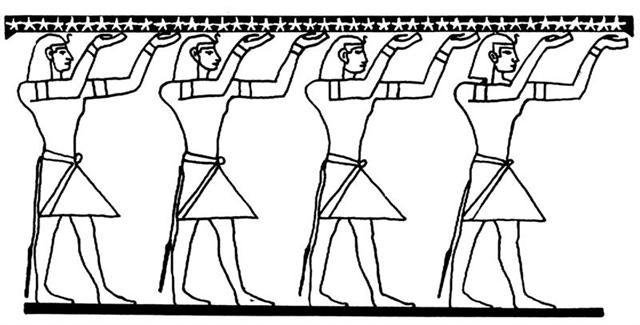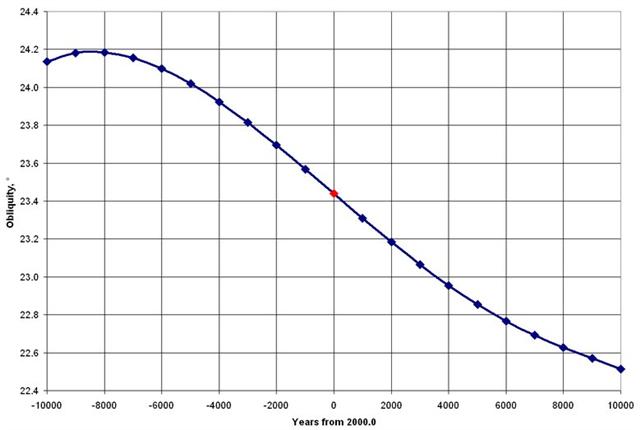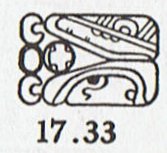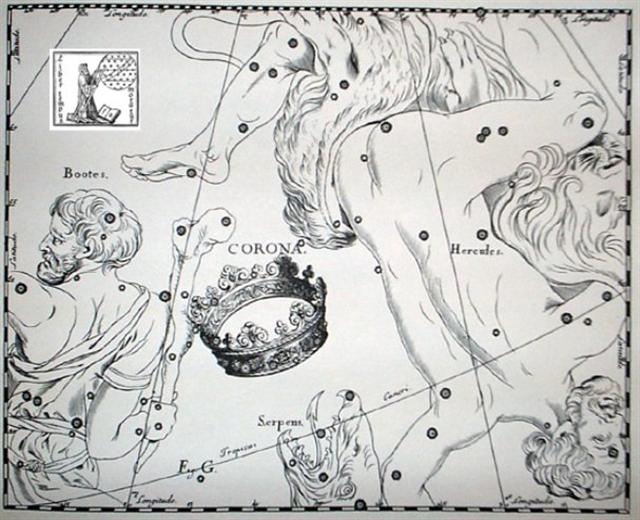Easter Island represented the 8th Land. It was an island ruled by the Moon (moving 'wither-shins').
It was an island outside the broad way of the Sun and it had always been so: ... Then three lines are drawn east and west, one across the northern section indicates the northern limit of the Sun (corresponding with the Tropic of Cancer) about the 15th and 16th days of the month Kaulua (i.e., the 21st or 22nd of June) and is called ke alanui polohiwa a Kane, the black-shining road of Kane. The line across the southern section indicates the southern limit of the Sun about the 15th or 16th days of the month Hilinama (December 22) and is called ke alanui polohiwa a Kanaloa, the black-shining road of Kanaloa. The line exactly around the middle of the sphere is called ke alanui a ke ku'uku'u, the road of the spider, and also ke alanui i ka Piko a Wakea, the way to the navel of Wakea (the Sky-father). Between these lines are the fixed stars of the various lands, na hokupaa a ka aina. (These are the stars which hang suspended in the zeniths of the Polynesian islands most of which lie within the tropics.) On the sides are the stars by which one navigates ...
... The four sat down [he noho] and pondered [he hakatopa] over the report [i te kī] (of the result of the explanation). Then the four said [he kī ahaha], 'One has to get up [ka ea.etahi] and let the king know the news (about the conditions on Easter Island)!' Raparenga [the Moon] got up, picked up the leaves, took them in his hands, and waved, waved, waved, [waved,] and waved. This was seen by the man who understood signals; he looked down and called out the following to the king: 'They are waving, they are signaling the following message: The land is bad; the shoots growing out of the ground cannot spread because the algae-like thicket is very long when it is pulled out, when it is ripped out (this means that the runners of the yam roots that were planted are unable to prevail against the heavy weeds, which have to be pulled out continually).' [E:76] Therefore, on Easter Island the Moon should be used for counting the nights (of the month) instead of the calendar of the Sun (for counting the days). Po. 1. Night; to get dark, to fall (of night): he-po, it is getting dark. Formerly used, with or without raá, in the meaning of a whole day: po tahi, one day; katahi te kauatu marima po, fifteen days; po tahi raá, first day of the week; po rua raá, po toru raá, second, third day, etc. 2. Alone or as po nui, used to express the idea of good luck, happiness. He-avai-atu au to'ou po, I wish you good luck (when taking leave of someone). Very common was this parting formula: aná po noho ki a koe! good luck to you! Po-á, morning; i te po-á, in the morning; i te po-era-á, very early in the morning. Po-ará, quickly, rapidly, swiftly: he-iri po-ará, go up quick; he-ta'o itau umu era po-ará, he cooked it quickly. Po-e-mahina, formerly used of sleep-walkers (haha a po). Vanaga. 1. Darkness, night, late; po haha, dark night, gloom. P Tu. po-tagotago, darkness. Mgv., Mq., Ta.: po, darkness, night. 2. Calendar day; po e rua, Tuesday; po o te tagata, life. P Pau., Mgv., Mq., Ta.: po, calendar day. Churchill. Raa. Sun; day; i te raá nei, today; raá îka, good day for fishing. Vanaga. 1. Sun. 2. Day. 3. Time. 4. Name of sub-tribe. Fischer. Te manu i te raá = comet. Barthel. '... The substitution of the sun for the sail, both of which are called ra or raa in Polynesia, is a remarkable feature in Easter Island art ... ' Heyerdahl 3. 1. The sun; raa ea mai, raa puneki, sunrise; raa tini, raa toa, noon. P Mgv., Ta.: ra, the sun. Mq.: a, id. 2. Day, date; a raa nei a, to-day, now; raa i mua, day before. P Mgv., Ta.: ra, a day. Mq.: a, id. Churchill. '... The chief thus makes his appearance at Lakeba from the sea, as a stranger to the land. Disembarking at the capital village of Tubou, he is led first to the chiefly house (vale levu) and next day to the central ceremonial ground (raaraa) of the island ...' (Islands of History) Ta.: toraaraa, to raise up. Churchill 2. LA, s. Haw., sun, light, day. N. Zeal., ra, sun, day. Marqu., a, id. Sam., la, id. Deriv.: Haw., lae, be light, clear, shining; lai, shining as the surface of the sea, calm, still; laelae and lailai, intens. Sam., lelei, something very good; lala, to shine; lalangi, to broil. Fiji., rai, to see, appear; rai-rai, a seer, a prophet. Teor., la, sun. Aru Islands, lara, id.; rarie, bright, shining. Amblaw., laei, sun, day. Irish, la, lae, day. Laghmani (Cabul), la'e, day. Sanskr., laj, lanj, to appear, shine; râj, to shine. Ved., to govern; s. a king. If, as Benfey intimates, the Sanskrit verb bhrâj, to shine, to beam, is 'probably abhi-râj', an already Vedic contraction, then the Polynesian root-word al and lae will reappear in several of the West Aryan dialects. Lat., flagrare, flamma, flamen. Greek, φλεγω, φλοξ. A.-Sax., blac, blæcan, &c. Probably the universal Polynesian lani, langi, rangi, ra'i, lanits (Malg.) designating the upper air, sky, heaven, and an epithet of chiefs, refers itself to the same original la, lai, lanj, referred to above, to which also be referred: Welsh, glan, clean pure, bright, holy. Sax. clæne, clean, pure. Swed., ren, clean. pure; grann (?), fine, elegant. It may be noted in connection with this word, either as a coincidence or as an instance of ancient connection, that in the old Chaldean the name of the sun and of the Supreme Deity was Ra, and that in Egypt the sun was also named Ra. LA², s. Haw., Sam., Tong., ra. N. Zeal., the sail of a canoe; abbreviated from, or itself an older form of, the Fiji. laca, a sail, also the mats from which the sails were made. Sunda., Mal., layar, sail. Malg., laï, sail, tent, flag. Sanskr., lâta (Pictet), a cloth; latâ (Benfey), a creeper, a plant; lak-taka, a rag. As mats and clothing in primitive times were made of bark or flexible plants, the connection between the Sanskrit latâ and Polynesian laca, la, becomes intelligible. Armen., lôtig, a mantle. Lat., lodix, a blanket. Irish, lothar, clothing. (Fornander) The Sun stood out at Sea and his rays could never flood the land from straight above (zenith).
He would always be held between the jaws of Fenrir, he would never come completely loose from the confinement between Father Sky and Mother Earth.
There was a viri in the A text which evidently was outside the order of Hermes Trismegisthos, viz. a viri which looked old and unhealthy (similar to a great fire turned into smouldering ashes):
664 (side b) + 340 (Aa5-7) = 1004 = 4 * 251.
We have found a pair of identical puo (dressed up) glyphs towards the end of side b and here we have a pair of identical viri glyphs late on side a:
|
||||||||||||||||||||||||||||||||||||||||||||||||||||||||||||||||||||||||||||||||||||||||||||||||||||||||||||||||||||||||||||||||||||||||||||||||||||










